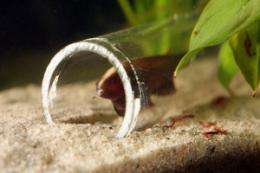Electric fish could spark healthcare innovation

(PhysOrg.com) -- Mathematicians in Manchester are hoping electric fish can give them clues to solving a fiendishly complex mathematical problem - which could in turn lead to better treatment for patients with lung problems.
A tank containing Peters’ Elephantnose Fish from Africa and Black Ghost Knifefish from South America has been installed in the School of Mathematics at The University of Manchester for a special conference on Biomedical Electrical Impedance Tomography (EIT).
Mathematicians say the fish have a natural ability to solve a mathematical conundrum related to EIT called the Inverse Conductivity problem - and so have invited them along as experts.
The fish generate an electric current and use voltage sensors on their surface to locate prey. In a similar way, EIT uses electric current to allow us to see inside objects without physically disturbing them.
Medical EIT can be used, for example, to monitor lungs in intensive care patients - and medical professionals have been invited to a special session at the University that focuses on using the technology for lung imaging.
It’s hoped that discussions with doctors and consultants on their needs and desires will help mathematicians provide effective solutions to real-life problems.
Prof Mark Nelson of the University of Illinois, an internationally renowned expert on electrosensing in fish, has also been invited to give a special talk to delegates about the behavior and capabilities of weakly electric fish.
And another event will bring together mathematicians with geophysicists and engineers, to discuss the challenges they face in using EIT in their respective fields.
Viewers of Channel 4’s Time Team will have seen EIT being used during the ‘geofizz’ process to identify areas of interest. Electrical engineers are also using EIT to see inside gas and oil pipelines and similar mathematics is used 3D airport body scanners.
Event organiser Prof Bill Lionheart from The School of Mathematics at The University of Manchester, said: “Weakly electric fish are really interesting to us because they have the ability to solve a very challenging mathematical problem when catching their food. Nature seems to have come up with a nice solution to the Inverse Conductivity problem, so we are keen to learn from them.
“Electrical Impedance Tomography has important applications in a range of different fields, ranging from medicine to archaeology.
“Researchers in these areas concentrate on making the technology work in vastly different ways - but the one thing that ties all their work together is the mathematics behind it.”
Andrew Gray, Curator of Herpetology at The Manchester Museum has advised the mathematicians on the keeping of the fish, while other invaluable advice has been provided by Britain’s Aquatic Superstore, Manchester Pets and Aquatics and Oasis Aquarium.
Provided by University of Manchester
















